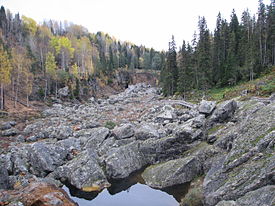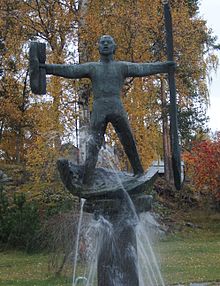- Döda Fallet
-
Döda Fallet (The dead waterfall) is an extinct whitewater rapid in Ragunda Municipality in the eastern part of the province of Jämtland in Sweden.
The Indalsälven river previously flowed through the 25 km[1] (16 mi) long lake Ragundasjön and then immediately over a high waterfall known then as Gedungsen or Storforsen (The great whitewater rapid). It was one of the most impressive waterfalls in Sweden with a total fall height of about 35 meters (115 feet) and a large water discharge.
Contents
Background
In the late 18th century, logging emerged as a major industry in the heavily forested region of Jämtland. The rivers were used as fast and relatively easy transportation of the timber to the coastal sawmills. The whitewater rapid Storforsen however was a major obstacle as it damaged or destroyed much of the timber, forcing use of land transportation (portaging) past the waterfall.
Because of this, a man named Magnus Huss, also known as Vildhussen (the Wild Huss), was in 1793 appointed to solve the problem by constructing a canal to bypass the waterfall. During 1794 and 1795 preliminary work such as clearing forest was carried out, but work on the canal channel did not begin until 1796, partly due to sabotage by locals who were skeptical or did not want to lose their paid work portaging the timber.
In early 1796 work on the canal started. It was however dug through unconsolidated glacial-outwash sand and gravel including an esker, and the spring flood of 1796 was unusually heavy. The porous ground beneath the canal could not withstand the force of the water, which started to quickly erode deep into the esker. In only four hours in the night of 6/7 June 1796 Ragundasjön drained completely, triggering a 15 metres (49 ft)-high flood wave moving down the river, causing much destruction and establishing the much deepened and scoured-out course of the canal as part of the river's new course. Despite being one of Sweden's largest environmental disasters, no one is believed to have been killed by the event. The washed-away soil and sediments redeposited at the Indalsälven's delta in the Baltic Sea north of Sundsvall, creating new land which Sundsvall-Härnösand Airport was later built on.
Storforsen, dried, is now called Döda Fallet (the Dead Fall). At a rock barrier in the bottom of the former Ragundasjön a new waterfall was formed, Hammarfallet in Hammarstrand, now turned into a hydroelectric power station. [1] [2]
Until 1796 varved sediment was accumulating on the bottom of Ragundasjön. That gives geologists an exact date for the last varve there; see Varve for dating by counting varves.
Heritage
Today Döda Fallet is a nature reserve and one of the major tourist attractions of the municipality. Every year there is a play commemorating what happened in the spring of 1796. Magnus Huss is remembered by a statue in the small nearby town of Hammarstrand, which was constructed on the former lake bed of Ragundasjön. Döda Fallet is also listed in Reader's Digests Natural wonders of the World.[2]
References
- "Döda fallet" (in Swedish). Ragunda turism. http://www.ragunda.se/vadsokerdu/dodafallet/dodafallet.4.1493102fa9fa32e2e7fff1475.html. Retrieved 2008-04-14.
Notes
- ^ "Ragundasjön" (in Swedish). Wikipedia. http://sv.wikipedia.org/wiki/Ragundasjön. Retrieved 2010-01-06.
- ^ Reader's Digest (1980). Natural Wonders of the World. ISBN 0-89577-087-3.
Categories:- Jämtland County
- Waterfalls of Sweden
- Indalsälven basin
- Dam disasters
- Nature reserves in Sweden
- Rapids
Wikimedia Foundation. 2010.


